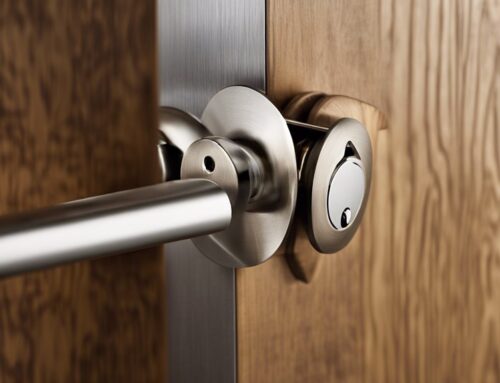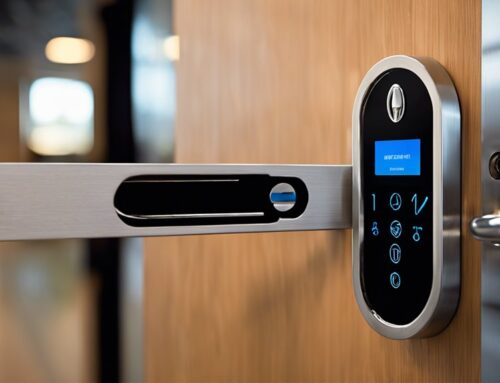It’s funny how you can stumble upon a topic at the perfect moment, like discovering time-delay combination locks just when you’re considering enhancing security for your own business. You might wonder how these systems manage to strike a balance between access and security. While they effectively deter unauthorized access, their inherent delays can frustrate legitimate users. So, how do you guarantee your security measures don’t hinder operations while still keeping potential threats at bay? Exploring this dilemma reveals essential insights vital for any organization.
Key Takeaways
- Time-delay locks enhance security by initiating a waiting period, deterring unauthorized access without compromising user convenience.
- Customizable delay durations allow organizations to tailor security measures according to specific risk profiles.
- Features such as dual user codes and randomized keypads prevent unauthorized entry while facilitating accountability among authorized personnel.
- Time-delay mechanisms provide a balance between necessary access and security by restricting quick manipulation or impulsive break-ins.
- Regular maintenance and updates are critical to ensure reliability and protection against potential vulnerabilities while maintaining user trust.
How Time-Delay Locks Function

Although time-delay locks might seem complex at first glance, they operate on straightforward principles designed to enhance security.
When you input your combination, the lock initiates a countdown timer that delays access, typically ranging from a few minutes to several hours. This mechanism effectively deters unauthorized access, as potential intruders can’t quickly manipulate the lock post-entry.
The lock also incorporates a unique feature allowing a single delay per session, preventing repeated attempts to override the system. As the timer runs, you must remain patient, observing strict protocols to access the lock’s mechanisms.
Understanding this functionality not only reinforces your security measures but also equips you with knowledge that can potentially safeguard valuable assets against theft.
Key Security Features
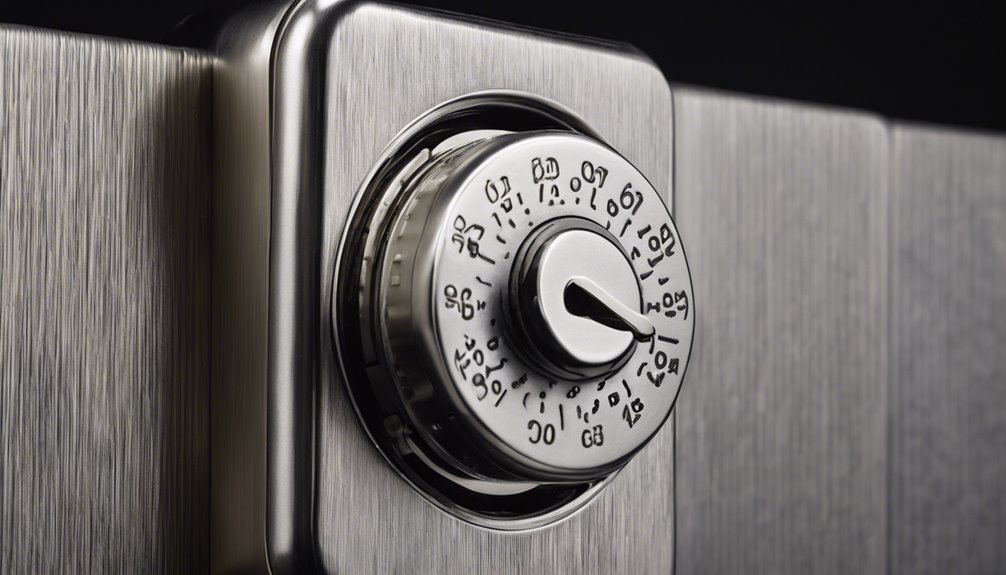
Time-delay combination locks come equipped with several key security features that enhance their effectiveness against unauthorized access. Understanding these features is essential for mastering their use.
- Time Delay: Introduces a mandatory waiting period before access is granted, deterring unauthorized entry during vulnerable moments. This added protection acts as a deterrent against potential break-ins.
- Lockout Mode: After multiple incorrect attempts, the lock may enter a state that temporarily disables access, further securing your assets.
- Dual User Codes: Provides the ability to assign separate codes for different users, ensuring accountability and traceability.
- Randomized Keypads: Some models offer a randomized layout, preventing key observation and reducing the likelihood of brute force attacks. In addition, the integration of advanced technology in security solutions can further enhance the effectiveness of these locks.
Benefits of Time-Delay Locks

Understanding the security features of time-delay combination locks highlights their practical benefits in safeguarding valuable assets. These locks deter unauthorized access effectively, allowing only lawful users the necessary time to respond. Additionally, the delays reduce impulsive theft attempts, enhancing overall security. Moreover, considering security upgrades when replacing locks can further fortify the protective measures in place. The selection of insurance-compliant locks is also vital in ensuring that property owners meet property insurance requirements.
| Benefit | Description |
|---|---|
| Increased Deterrence | Delays discourage quick break-ins. |
| Controlled Access | Limits entry to authorized personnel. |
| Enhanced Security | Combines time-delay with locking. |
| Reduced Risk of Theft | Lessens chance of impulsive thefts. |
| User Familiarity | Simple operation promotes compliance. |
Time-delay combination locks balance accessibility and security, making them an ideal choice for protecting high-value assets without compromising user experience.
Typical Use Cases
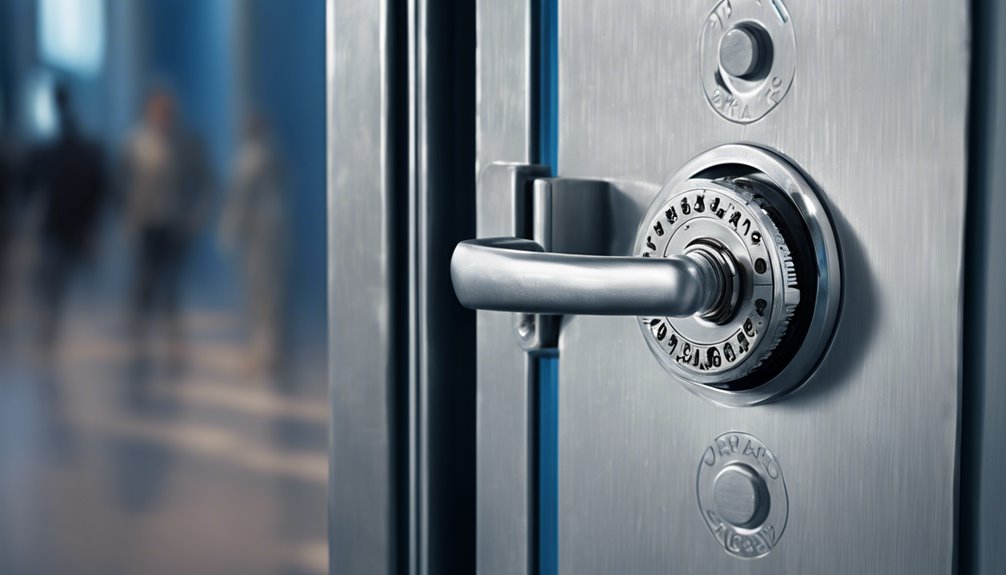
Time-delay combination locks are ideal for specific scenarios, particularly in retail cash handling and high-security facility access.
In retail environments, these locks provide an added layer of security during cash transactions, deterring potential theft.
Similarly, in high-security facilities, they help safeguard sensitive areas by controlling access and ensuring that any unauthorized attempts are visibly delayed.
Retail Cash Handling
Effective cash handling is essential for retail operations, shaping both security and efficiency.
Implementing time-delay combination locks can serve various roles in this situation, enhancing your cash management practices. Here are some typical use cases:
- Cash Registers: Securely store cash during and after business hours to deter theft.
- Safe Storage: Protect larger sums of cash until banking or scheduled withdrawals are made.
- Employee Access Control: Restrict access to cash for only trusted personnel, minimizing internal theft risks.
- Routine Deposits: Facilitate secure, timed access for scheduled cash deposits, ensuring safety during transactions.
High-Security Facility Access
While ensuring security in high-stakes environments, adopting time-delay combination locks can greatly enhance access control.
These locks serve as a formidable barrier in facilities like government buildings, data centers, and financial institutions. When you integrate time-delay mechanisms, you effectively minimize the risk of unauthorized access by requiring users to wait before securing entry, thwarting potential quick breaches.
In environments where sensitive information and assets are at stake, the delay allows security personnel to monitor and respond to any anomalies. Additionally, these locks can be programmed to restrict access during specific times, further enhancing security protocols.
With precise deployment, you can strike a favorable balance between robust security measures and controlled access, ensuring your facility remains both secure and efficient.
Technical Specifications
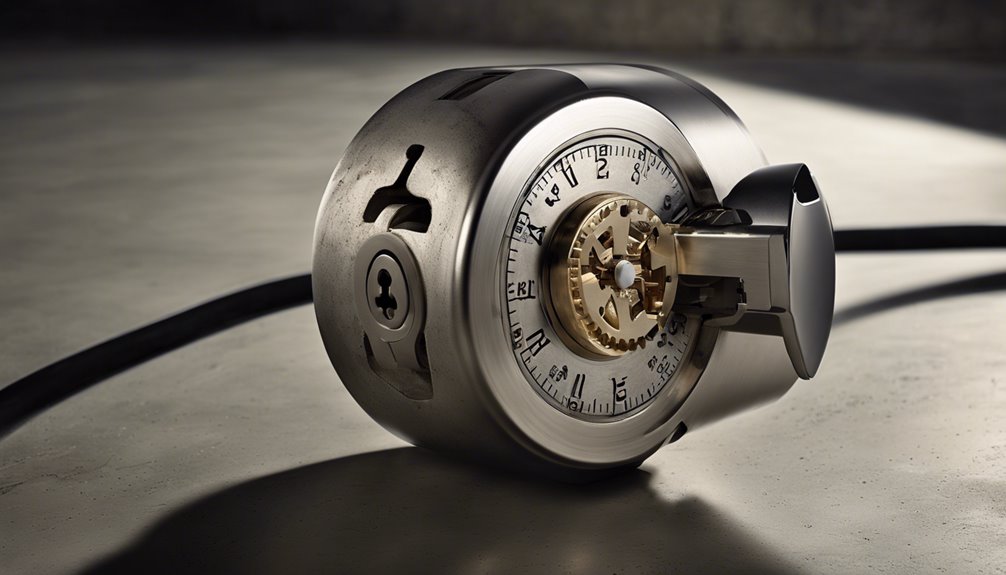
When it comes to technical specifications, understanding the components of time-delay combination locks is essential for their effective application.
These locks blend mechanical ingenuity with electronic access control, ensuring robust security. Key features include:
- Delay Mechanism: This is the core functionality, allowing a set delay before the lock disengages after the correct combination is entered.
- User Interface: Typically consists of a keypad or dial, designed for both ease of use and durability.
- Power Source: Most rely on batteries or mains power, with backup options to prevent failure.
- Material Composition: High-quality alloys or reinforced materials enhance resistance to tampering and environmental factors.
Familiarizing yourself with these specifications will empower you to make informed decisions in your security planning.
Historical Development

To understand the historical development of time-delay combination locks, you must examine their mechanical origins and evolution over the years.
You’ll see how patent innovations have greatly enhanced security features, leading to a shift toward digital technology.
This change marks a pivotal moment in the design and functionality of these locks, reflecting advancements in both security needs and technological capabilities.
Mechanical Origins and Evolution
As the quest for security intensified in ancient civilizations, so did the innovation behind locks, leading to the development of time-delay combination locks.
These locks evolved from rudimentary mechanisms to sophisticated security devices, influenced by four key factors:
- Cultural Demands: Societal needs for protection spurred mechanical advancements.
- Technological Progress: The advent of metallurgy enabled more durable components.
- Mathematical Concepts: Increased understanding of permutations influenced combination designs.
- Criminal Techniques: The evolution of theft tactics prompted more complex lock systems.
Each milestone contributed to the refinement of mechanical locking systems, integrating time-delay features that enhanced security while balancing accessibility.
You see, understanding these origins equips you to better appreciate modern security solutions.
Patent Innovations and Improvements
While the evolution of time-delay combination locks was heavily influenced by cultural and technological shifts, patent innovations played a significant role in refining these devices. Each patent encapsulated distinct mechanical improvements—enhancing security features and operational efficiency.
For instance, innovations introduced more complex locking mechanisms that increased the time required for unauthorized access. Additionally, patents focused on user interfaces, simplifying the combination input process while retaining advanced security protocols.
Other patents incorporated time-delay mechanisms that randomized access intervals, further complicating potential breaches. By fostering inventive design and thoughtful application, these patents laid the groundwork for modern security expectations.
Therefore, understanding these historical developments is essential for recognizing the balance between user accessibility and robust security inherent in contemporary locks.
Shift to Digital Technology
The advancements in patent innovations set the stage for a significant change toward digital technology in combination locks. This alteration has markedly enhanced security and user experience.
By embracing digital mechanisms, you’re able to leverage several key benefits:
- Enhanced Security: Advanced encryption methods make unauthorized access exceedingly difficult. Smart locks typically utilize robust encryption to secure data and prevent hacking attempts.
- User Flexibility: Digital locks allow for multiple user codes, facilitating easier access management.
- Remote Access: Many systems now offer smartphone integration, granting you control from anywhere.
- Audit Trails: Digital locks can record access attempts, creating a verifiable security log.
Additionally, real-time monitoring through integrated systems can further bolster security by allowing immediate responses to unauthorized access attempts.
These developments represent a progressive move beyond traditional mechanical locks, emphasizing the need for sophisticated solutions in an increasingly digital world.
Adapting to this technology can fundamentally change how you approach security.
Comparison: Mechanical vs. Digital

When choosing between mechanical and digital time-delay combination locks, understanding their fundamental differences can greatly influence your decision.
Mechanical locks rely on physical components and can offer reliability without the need for power. They’re less susceptible to hacking but may require more manual intervention. Additionally, traditional security systems, like mechanical locks, are known for their reliable detection methods, ensuring a consistent performance.
On the other hand, digital locks provide more advanced features, such as audit trails and programmable access codes, enhancing usability. They often require batteries, which could present a vulnerability if not monitored.
While mechanical locks typically feature simpler designs, digital variants may offer user-friendly interfaces. Additionally, smart locks can enhance security with options like remote access control, providing convenience and flexibility for users.
Ultimately, the choice hinges on your specific security needs, balancing the desired ease of access with the level of protection you aim to achieve.
User Customization Options
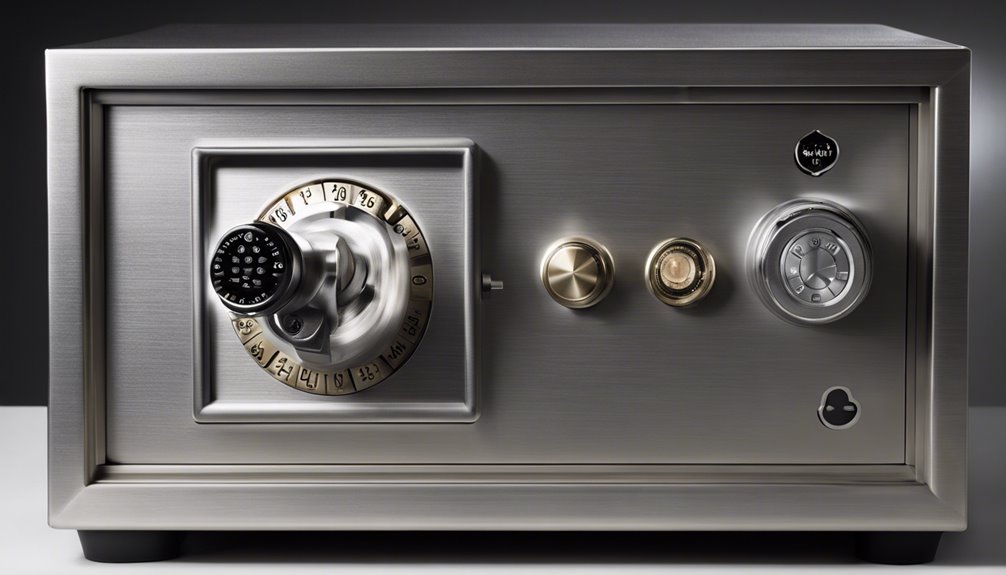
Choosing a time-delay combination lock with user customization options can greatly enhance your security experience.
Customization allows you to tailor the lock’s features to suit your specific needs, increasing both accessibility and protection. Here are four key options to evaluate:
- Personalized Access Codes: Create unique codes for individual users, minimizing unauthorized access.
- Adjustable Time Delays: Set delay periods that align with your security preferences, whether for quick access or extended delay. This feature can help maintain security similarly to re-keying smart locks, as both methods provide users with control over their access.
- User Profiles: Program multiple profiles for varied access levels, allowing specific permissions for different users.
- Tamper Alerts: Enable notifications for unauthorized attempts, enhancing your awareness and response.
These options empower you to establish a security system that aligns precisely with your lifestyle and requirements. Additionally, using 24/7 availability for lock rekeying ensures that your customized security features can be maintained and updated whenever necessary.
Challenges and Limitations

Time-delay combination locks can lead to user frustration as individuals often face significant wait times before gaining access.
Additionally, these systems may possess bypass vulnerabilities that could be exploited by determined intruders.
Understanding these challenges is essential for evaluating the overall effectiveness and reliability of these security devices.
User Frustration During Delays
Frustration often creeps in as users encounter the inherent delays associated with time-delay combination locks. The waiting period can lead to negative experiences that impact overall effectiveness.
Consider these factors:
- Inefficiency: Longer waits during high-stress scenarios can hinder productivity.
- User Anxiety: The ticking clock amplifies tension, which may lead to mistakes.
- Perceived Security: Users might question the reliability of the lock if delays feel excessive.
- Operational Interruptions: Frequent delays disrupt workflow, frustrating users who value efficiency.
As you grapple with these challenges, it’s crucial to recognize how these delays can erode trust in the locking mechanism, ultimately undermining its intended purpose of balancing security with access.
Mastery of the user experience is critical in mitigating these frustrations.
Potential Bypass Vulnerabilities
Inevitably, the concerns surrounding user frustration during delays bring attention to another significant aspect of time-delay combination locks: their potential vulnerabilities. While these locks offer improved security, threats exist that savvy individuals can exploit. Illusion of security can lead users to underestimate the risks associated with these locks.
| Bypass Method | Description |
|---|---|
| Social Engineering | Manipulating users or staff to gain access. |
| Timing Exploits | Observing and predicting delay mechanisms. |
| Technical Manipulation | Utilizing tools to override the lock. |
| Physical Tampering | Damage or alteration of the lock’s mechanism. |
Understanding these vulnerabilities is essential. You must balance security features with their inherent weaknesses to guarantee maximum protection while minimizing risks. Scrutinizing these aspects will enhance your mastery over time-delay combination locks. Additionally, it’s vital to consider that opting for poor-quality services, like cheap locksmith services, can exacerbate security risks if installers don’t correctly implement effective mechanisms.
Future of Time-Delay Locks
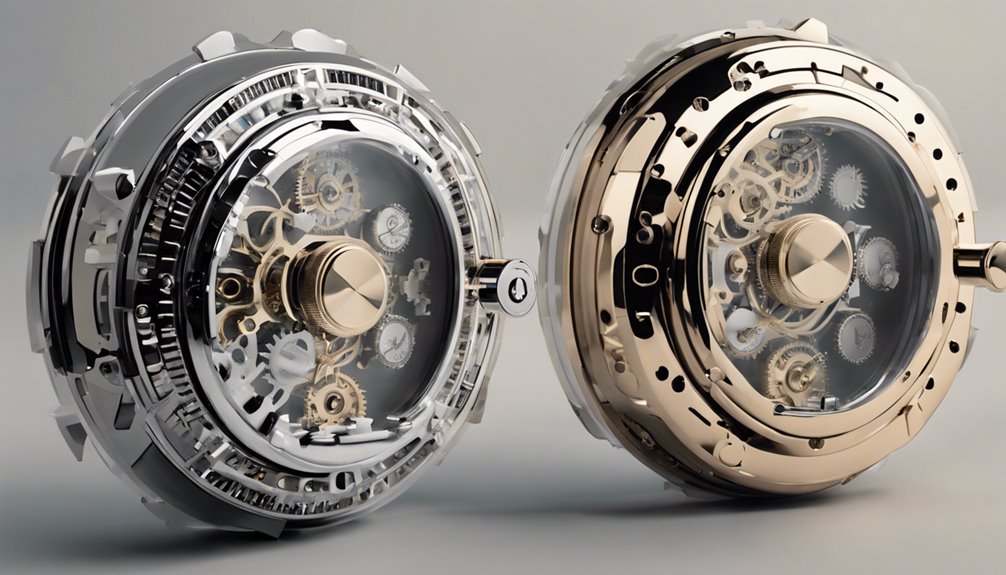
As advancements in security technology continue to evolve, the future of time-delay locks looks promising and may integrate even more sophisticated features.
You can expect the following enhancements:
- Biometric Integration: Fingerprint or facial recognition to improve user identity verification.
- Smart Connectivity: Integration with IoT devices for real-time monitoring and alerts.
- Adaptive Algorithms: Intelligence that learns access patterns to optimize time delays based on threat levels, similar to smart home security systems designed for enhanced safety.
- Remote Management: Ability to control locks remotely, providing flexibility and increased security.
Additionally, emerging technologies such as AI-powered algorithms can enhance the effectiveness of time-delay locks by enabling smart monitoring and proactive threat detection.
These innovations aim to bolster both convenience and protection, ensuring that time-delay locks remain competitive in a dynamic security landscape.
Frequently Asked Questions
Can Time-Delay Combination Locks Be Hacked or Bypassed?
Yes, time-delay combination locks can potentially be hacked or bypassed. While they provide enhanced security through time delays and complex combinations, skilled individuals might exploit vulnerabilities, using methods like brute force or manipulation of the lock’s mechanics.
You should stay informed on the latest security updates and practices to minimize risks. Remember, no lock is entirely infallible; it’s essential to combine multiple security measures for best protection.
How Often Should I Change My Lock Codes?
You should change your lock codes regularly to improve security—at least every three to six months.
While it might seem cumbersome, think of the peace of mind it brings.
Change codes more frequently if there’s a security breach or personnel changes.
Regular updates guarantee that even if someone had access to your previous code, they can’t exploit it indefinitely, keeping your premises and possessions safe and secure from unauthorized access.
What Happens During a Power Outage?
During a power outage, your security systems may be compromised. If you rely on electric locks or alarms, you’ll find them non-functional, leaving your property vulnerable.
It’s essential to assess backup mechanisms; some systems revert to manual operation or have battery backups.
Check your setup, ensuring that emergency plans are in place. You need to understand the limitations of your devices during outages to maintain security and effectively respond to potential threats.
Are Time-Delay Locks Suitable for Residential Use?
Sure, who wouldn’t want their front door to take its sweet time opening?
But seriously, time-delay locks can be quite suitable for residential use if you value both security and patience. They add layers of protection, discouraging quick break-ins.
However, consider the trade-off—while it’s great to slow down intruders, that delay might frustrate you or your loved ones.
How Do I Maintain My Time-Delay Combination Lock?
To maintain your time-delay combination lock, regularly inspect the mechanism for dirt or wear.
Clean it gently with a soft cloth and avoid moisture.
Lubricate the internal components with appropriate oil to guarantee smooth operation.
You should also check the batteries, if applicable, and replace them as needed.
Finally, test the combination periodically to verify functionality, and keep the locking mechanism engaged when not in use to prevent any malfunctions.
Conclusion
In conclusion, time-delay combination locks are the gatekeepers of security, balancing access and protection like a well-tuned orchestra. Their robust features deter unauthorized entries while ensuring operational efficiency. As these locks evolve, user experience and customization options will play a pivotal role in their success. Embracing both their merits and challenges, you can appreciate the intricate design that stands between vulnerability and resilience, creating a seamless blend of security in high-risk environments.


